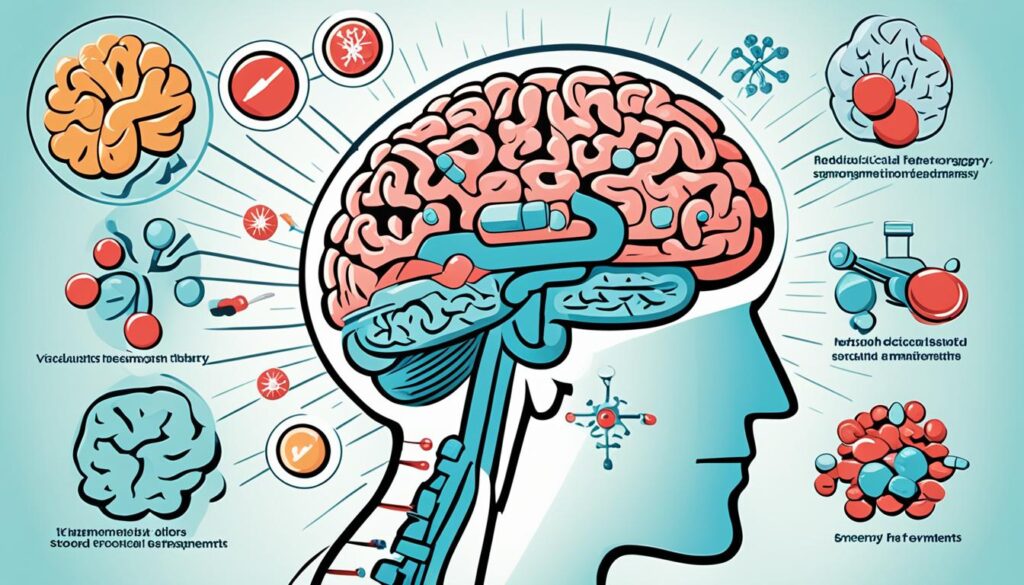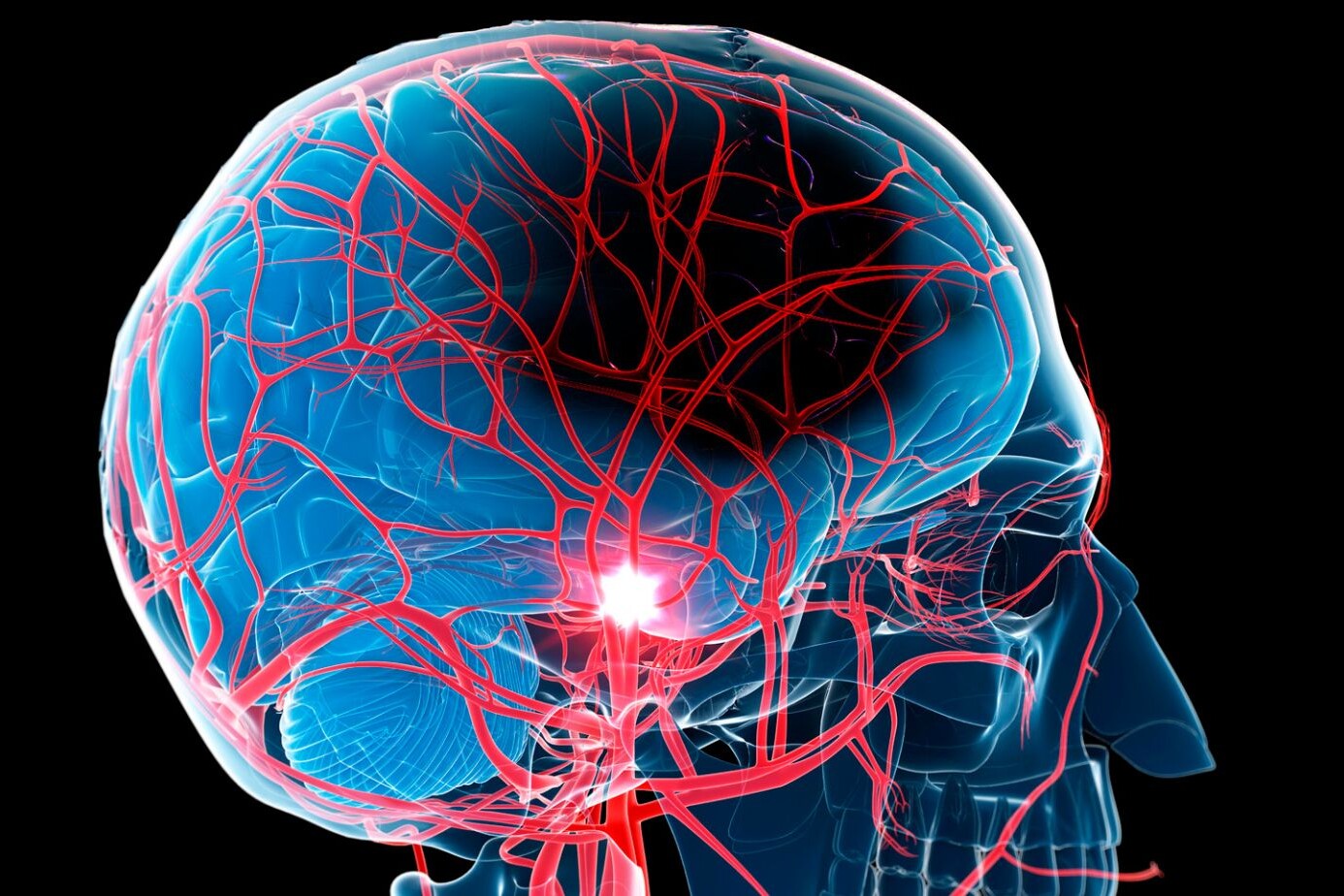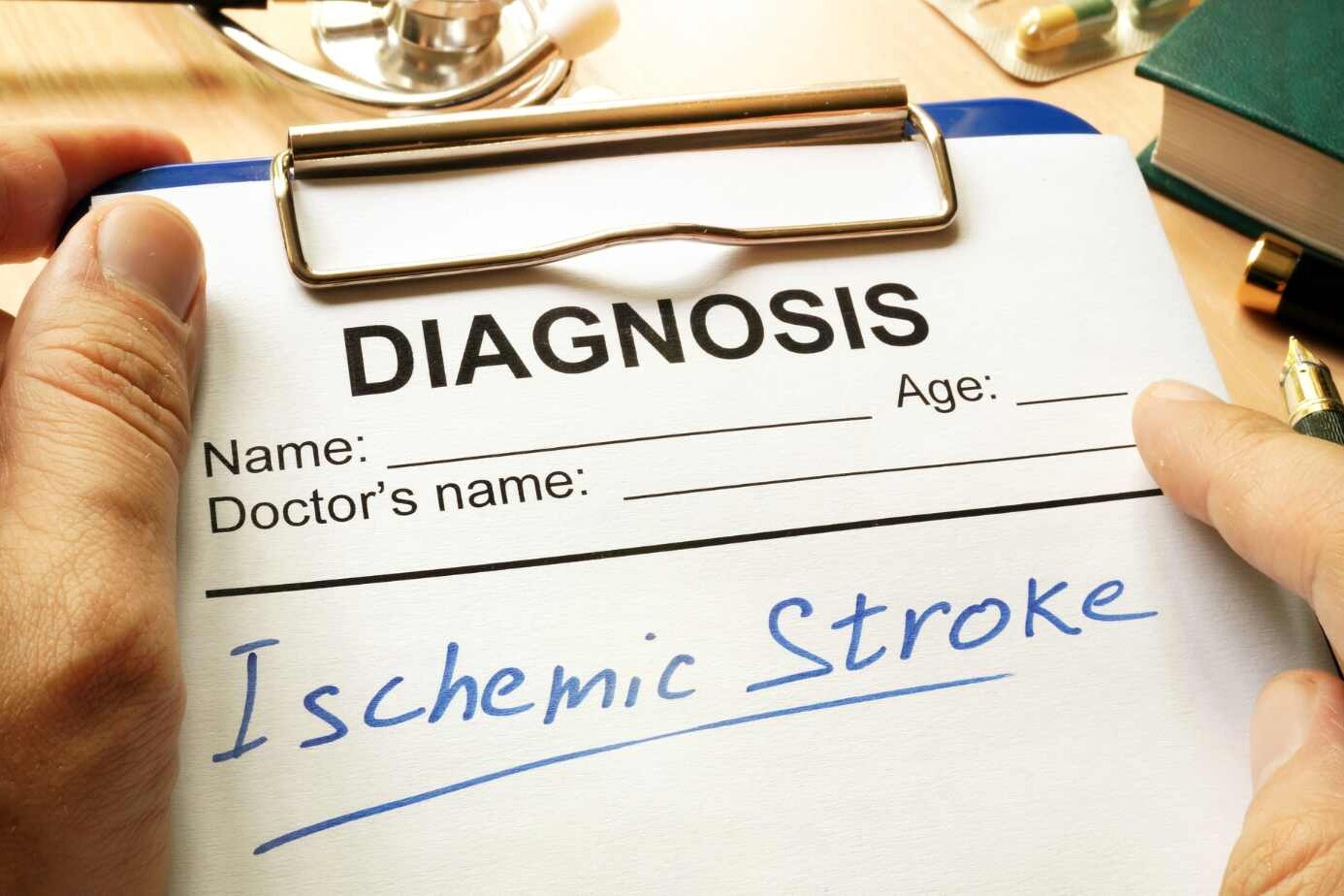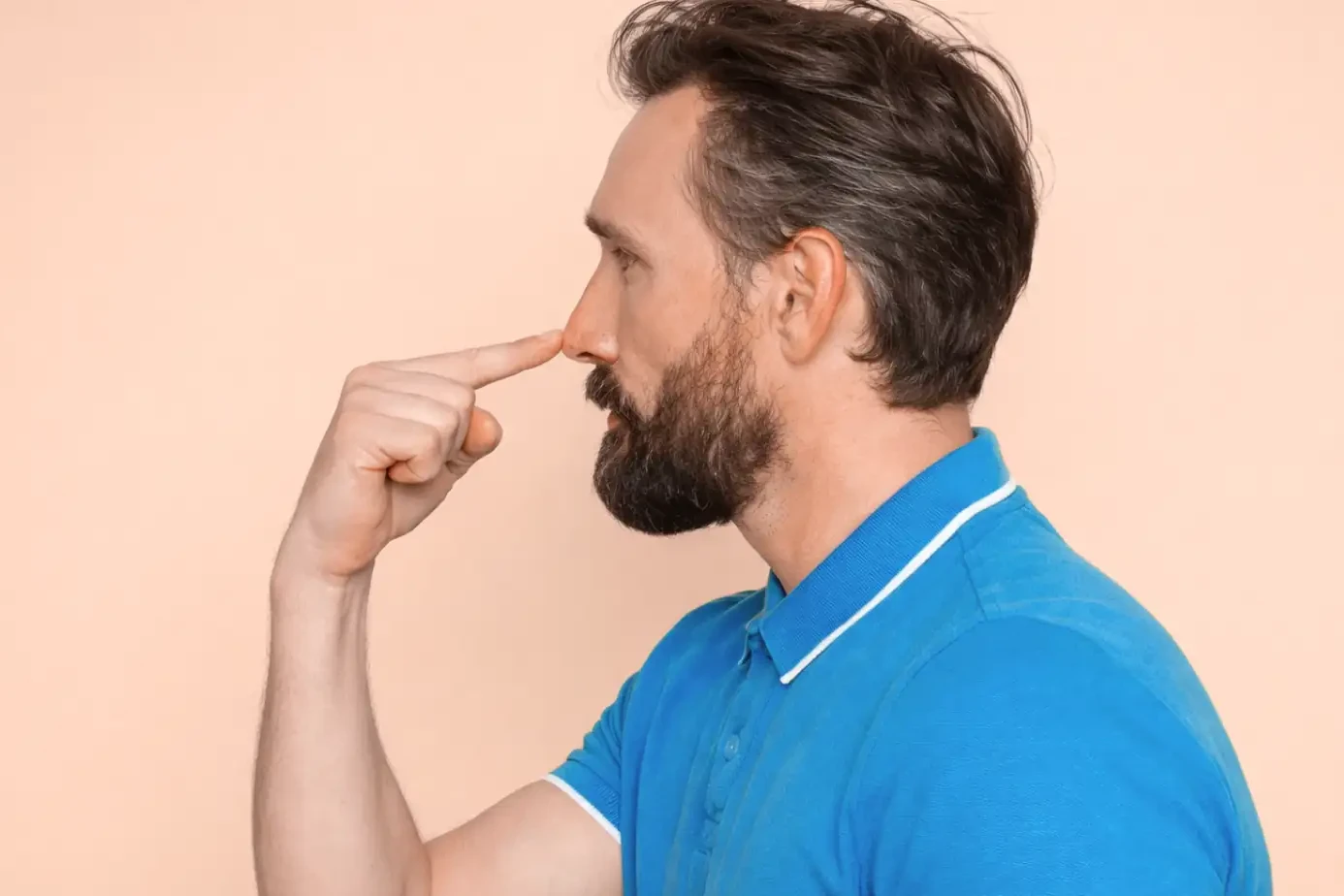Ischemic stroke is the top type of stroke, making up about 87% of all cases. It is caused by a blockage in the brain’s arteries. This blockage, or clot, can be from fatty deposits in blood vessels or from blood clots forming in other parts of the body. Carotid artery disease, which narrows the neck’s arteries supplying the brain, is also a leading cause.
Strokes rank as the fifth top cause of death in the U.S. Getting quick help is key to survival and recovery. Signs like facial drooping, arm weakness, and trouble speaking mean you need to act fast. By calling for help right away, you can lower the risk of severe brain damage and have a better chance at recovery.
Table of Contents
ToggleWhat is Ischemic Stroke?
Definition and Overview
Ischemic stroke happens when a blood clot blocks blood flow to the brain. This is mostly due to a clot or plaque in the arteries. As blood flow stops, the brain is not getting oxygen or nutrients. This can cause brain cells to die. Ischemic strokes are the most common type, making up about 87% of all stroke cases.
Statistics and Prevalence
In the United States, strokes are the fifth biggest cause of death. They affect about 800,000 people yearly. An ischemic stroke is very serious and life-threatening. It is crucial to know the signs and act fast to get medical help. Doing this can lower brain damage and improve survival and recovery chances.
Causes of Ischemic Stroke
Ischemic strokes happen mostly because of atherosclerosis. This is when fatty deposits and plaque block the arteries. These blockages can cause blood clots. If a clot moves to the brain, it can block a blood vessel there. Then, an ischemic stroke occurs.
Atherosclerosis and Plaque Buildup
Atherosclerosis is the main reason for ischemic strokes. It happens when fatty deposits and plaque block the arteries. This blocks blood flow to the brain. Eventually, it can cause an ischemic stroke.
Blood Clots and Blockages
Besides atherosclerosis, blood clots from other parts of the body can lead to an ischemic stroke. Conditions like irregular heart rhythms can create these clots. If one of these clots goes to the brain, it can block a blood vessel.
Carotid Artery Disease
Carotid artery disease also plays a big role in causing ischemic strokes. It’s when the arteries in the neck, bringing blood to the brain, get blocked. This blockage can cause a stroke by stopping blood flow to the brain.
Risk Factors for Ischemic Stroke
High blood pressure is a big cause of stroke. It makes blood vessels weak over time. Diabetes raises the risk by causing blood vessel problems.
Atrial Fibrillation
Atrial fibrillation leads to an uneven heartbeat. It ties to about 15% of ischemic strokes.
Having too much “bad” LDL or not enough “good” HDL can lead to artery blockage. This is a key ischemic stroke risk factor.
Sedentary Lifestyle and Obesity
Not moving much and being overweight are also bad. They can raise blood pressure and increase cholesterol. This leads to more stroke threats.
Age and Family History
Your age matters for stroke risks. The danger grows after 55. It keeps going up as you get older. Having a transient ischemic attack (TIA), or “mini-stroke,” makes a severe stroke more likely.
| Risk Factor | Increased Stroke Risk |
|---|---|
| High Blood Pressure | Primary cause of stroke |
| Diabetes | Significantly increases risk |
| Atrial Fibrillation | Accounts for 15% of ischemic strokes |
| High Cholesterol | Contributes to plaque buildup |
| Sedentary Lifestyle and Obesity | Lead to other stroke risk factors |
| Age | Risk doubles with each decade past 55 |
| Previous TIA | Nearly 10 times more likely to have a stroke |
Smoking and Ischemic Stroke
Smoking is a big risk for ischemic stroke. It makes blood vessels get more plaque and clot easily. This can lead to a blockage in the arteries, causing a stroke.
Research shows smoking increases the chances of both stroke types. In China, ten years of study connected smoking with stroke risk. Alcohol and smoking in young women also increases this risk.
A review found smoking is linked to more heart problems like atrial fibrillation. It also ups the chances of stroke in men with high blood pressure. For middle-aged women, the risk of stroke goes up too.
Not only smoking, but being around smokers also heightens stroke risk. This happens because secondhand smoke can cause strokes too. Women who are around smoking are also more at risk.
Chronic smoking makes arteries stiff and increases the chance of stroke. This happens even if you’re not the one smoking, if your spouse does. Both active and passive smoking make it more likely for people to develop arterial plaque.
Smoking increases the risk of a certain type of stroke, but this risk drops after quitting. Still, longtime smokers face a six times higher risk of stroke than non-smokers. So, quitting is crucial for lowering the stroke danger.
A 2010 study linked 19% of global strokes to smoking. In the U.S., this might mean 152,000 yearly strokes result from smoking. Living with a smoker doubles stroke risk. Doctors say smoking also makes stroke risk 2 to 4 times higher.
Stopping smoking is key to avoiding many health issues, including stroke. Exercise and health monitoring also lessen stroke risk by improving body functions and keeping diseases in check.

Types of Ischemic Stroke
Ischemic strokes may happen when blood flow to the brain is blocked. Different blockages can cause different stroke types. Knowing these subtypes helps with fast diagnosis and the right treatment for ischemic stroke.
Embolic Stroke
An embolic stroke occurs when a clot from elsewhere gets to the brain. It blocks a blood vessel there. This type makes up 30-40% of all ischemic strokes.
Thrombotic Stroke
Thrombotic strokes are from a clot forming in a brain blood vessel. They’re the most common, about 60-70% of cases. They often affect older people with high cholesterol, atherosclerosis, or diabetes.
Both embolic and thrombotic strokes stop blood flow to the brain. This can lead to brain cell death. Knowing the signs and getting help fast is key to reducing damage and surviving.
Symptoms and Signs of Ischemic Stroke
Ischemic stroke symptoms come fast, usually affecting just one side of the body. Remembering the F.A.S.T. acronym is advised by the American Stroke Association. This includes F for Face drooping, A for Arm weakness, S for Speech problems, and T for Time to call 911.
F.A.S.T. Acronym
The F.A.S.T. method helps spot ischemic stroke signs. If you see your Face droop, Arm weak, or Speech off, take quick Timely action. Call for help right away.
Other Sudden Symptoms
Ischemic strokes might also show as trouble walking, feeling dizzy, or falling for no reason. Other signs can be not understanding words, feeling confused, losing vision fast, or having a bad headache suddenly.
Getting help fast is very important in these cases. Acting quickly can lessen the harm to your brain. It also boosts the chances of getting better and surviving.
Causes of Ischemic Stroke
Ischemic stroke happens when arteries near the brain get blocked. This blockage is often from fatty deposits, also known as atherosclerosis, and blood clots. These clots can break off and stop blood flow to the brain. Another common cause is carotid artery disease, which makes the arteries in the neck narrow. This then reduces the amount of blood going to the brain.
Cholesterol-rich plaque can also cause arteries to become narrow and hard. This happens when atherosclerosis builds up in the artery walls. In addition to blocking the blood flow, this plaque can break off. If it does, it can form a clot that blocks a blood vessel in the brain. This is also a cause of ischemic stroke.
Sometimes, blood clots can start in the heart. If these clots make their way to the brain, they can cause an ischemic stroke. This often happens with a health issue called atrial fibrillation. Atrial fibrillation can make it easier for blood clots to form.
Problems with the carotid arteries are another key reason for ischemic strokes. When these arteries get too narrow or blocked, they limit the flow of oxygen-rich blood to the brain. This can result in an ischemic stroke.
Knowing the causes of ischemic stroke helps in preventing and dealing with it. It’s good to manage high blood pressure, high cholesterol, and other risky habits. This way, you lower the chance of having an ischemic stroke.
Treatment and Management
Swift medical care is key for better survival chances and recovery from an ischemic stroke. A rescue team might use tissue plasminogen activator (tPA) through a vein in your arm. This medicine can open the clot and bring back blood flow to your brain. It works best if given within 4 hours of stroke signs.
Clot-Busting Medication
TPA (tissue plasminogen activator) is an injectable used within the first three hours after symptoms appear. Doctors can also give it up to 4.5 hours after symptoms start. This IV treatment helps dissolve the clot in an ischemic stroke, but it’s most effective under 4.5 hours.
Mechanical Thrombectomy
A mechanical thrombectomy might be an option. Doctors use a catheter to take out the clot from the blocked blood vessel. This should happen within 6 hours of you noticing stroke symptoms. This method can help lessen long-lasting disability, but it’s only useful in the first 24 hours.
Every second counts in lessening brain harm and bettering the results for someone with an ischemic stroke.

Conclusion
Ischemic strokes are the most common and are very serious. They need quick medical help. Knowing what causes them, like atherosclerosis, blood clots, and issues with the carotid artery, is key to staying healthy. This knowledge helps in preventing strokes and getting early treatment. If you see signs of stroke, like the face drooping, or having weak arms and trouble speaking, call for help right away. This improves the chances of getting better.
Although strokes can be bad, you can lower your risk. Keep conditions such as high blood pressure and diabetes under control. Live a healthy life and follow your doctor’s advice. The American Heart Association has guidelines for stroke care. These tips help with new treatments and the best ways to manage strokes.
With quick action and proper care, many people can bounce back from a stroke. They can keep living full lives. Knowing about strokes, their risks, and the need for fast care is vital. It lets you do things to keep your health safe. This can lessen the impact of such a serious condition.
FAQ
What is ischemic stroke?
Ischemic stroke is the most common kind, making up about 87% of all strokes. It happens when an artery to the brain gets blocked. This blockage can come from atherosclerosis or blood clots.
What are the common causes of ischemic stroke?
The main causes are atherosclerosis and blood clots. Atherosclerosis is the buildup of fat and plaque in blood vessels. Blood clots can form and travel to the brain, blocking its vessels. Another cause is carotid artery disease, which narrows the neck arteries supplying blood to the brain.
What are the risk factors for ischemic stroke?
Risk factors include high blood pressure, diabetes, and atrial fibrillation. High cholesterol, not moving much, being overweight, getting older, and having had a TIA before also increase your risk.
How does smoking affect the risk of ischemic stroke?
Smoking raises the risk a lot by adding to the plaque in blood vessels. This makes blood clot easier. It also boosts cholesterol, narrows the vessels, and harms the vessel linings.
What are the different types of ischemic stroke?
There are two main types of ischemic strokes. Embolic strokes occur when a blood clot from somewhere else moves to the brain. Thrombotic strokes happen when a clot forms inside a brain blood vessel.
What are the signs and symptoms of an ischemic stroke?
Signs are sudden and might include a droopy face, weak arm, or trouble speaking. A severe, sudden headache can also be a sign. Remember F.A.S.T. for stroke signs, as advised by the American Stroke Association.
How is ischemic stroke treated?
Quick medical help is key. Doctors might give a clot-busting medicine or do a mechanical thrombectomy. This procedure removes the clot, helping blood flow return to the brain.
Source Links
- https://www.mayoclinic.org/diseases-conditions/stroke/symptoms-causes/syc-20350113
- https://www.medicalnewstoday.com/articles/318098
- https://www.hopkinsmedicine.org/health/conditions-and-diseases/stroke
- https://my.clevelandclinic.org/health/diseases/24208-ischemic-stroke-clots
- https://www.nhs.uk/conditions/stroke/causes/
- https://www.ncbi.nlm.nih.gov/pmc/articles/PMC6708836/
- https://www.ncbi.nlm.nih.gov/pmc/articles/PMC2928253/
- https://www.medicalnewstoday.com/articles/can-smoking-cause-a-stroke
- https://www.webmd.com/stroke/types-stroke
- https://www.hopkinsmedicine.org/health/conditions-and-diseases/stroke/types-of-stroke
- https://medlineplus.gov/ischemicstroke.html
- https://www.stroke.org/en/about-stroke/types-of-stroke/ischemic-stroke-clots
- https://www.mayoclinic.org/diseases-conditions/stroke/diagnosis-treatment/drc-20350119
- https://www.uptodate.com/contents/ischemic-stroke-treatment-beyond-the-basics
- https://www.ncbi.nlm.nih.gov/pmc/articles/PMC6707502/
About The Author

This article is medically reviewed by Dr. Chandril Chugh, Board-Certified Neurologist, providing expert insights and reliable health information.
Dr. Chandril Chugh is a U.S.-trained neurologist with over a decade of experience. Known for his compassionate care, he specializes in treating neurological conditions such as migraines, epilepsy, and Parkinson’s disease. Dr. Chugh is highly regarded for his patient-centered approach and dedication to providing personalized care.
→ Book a consultation to discover which remedies suit your needs best.




